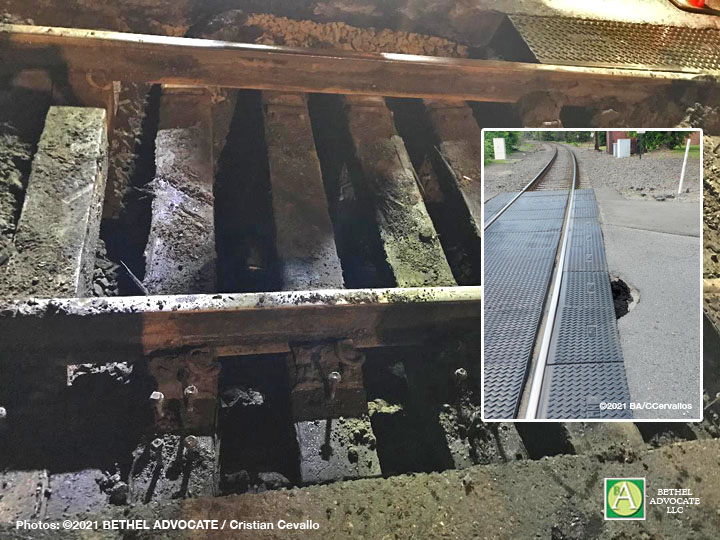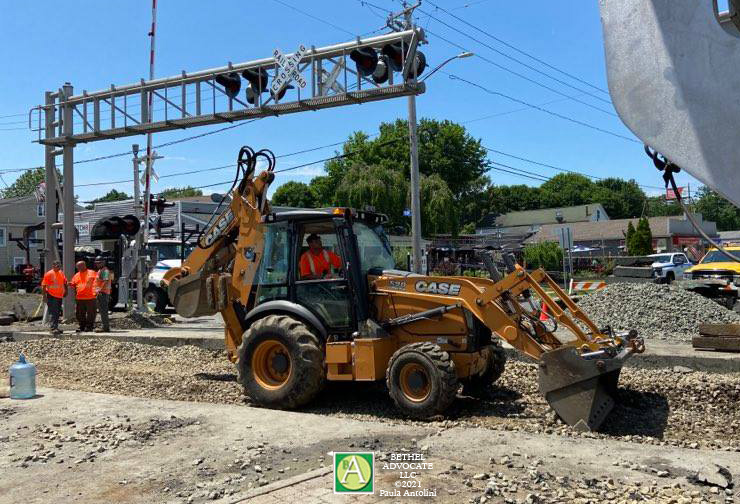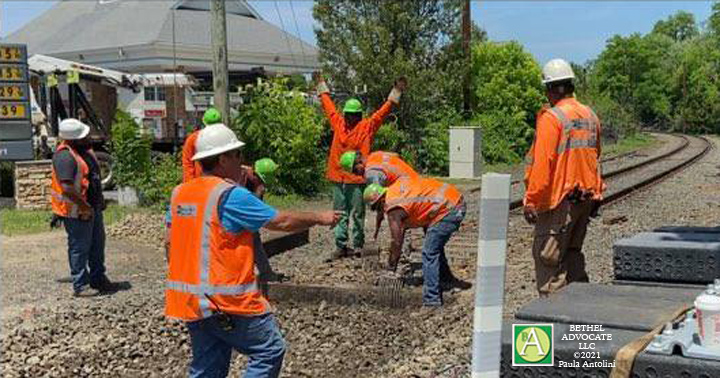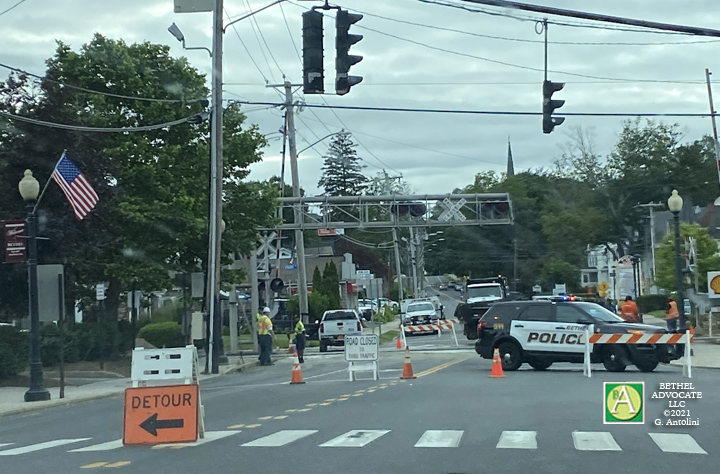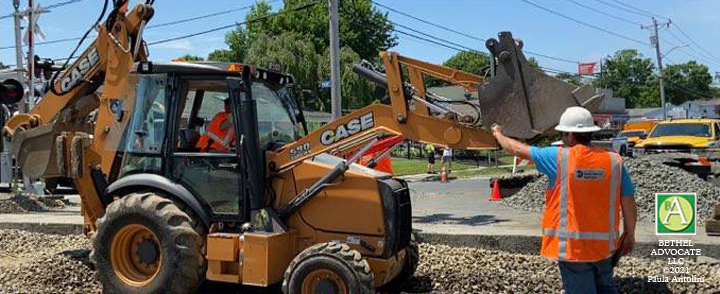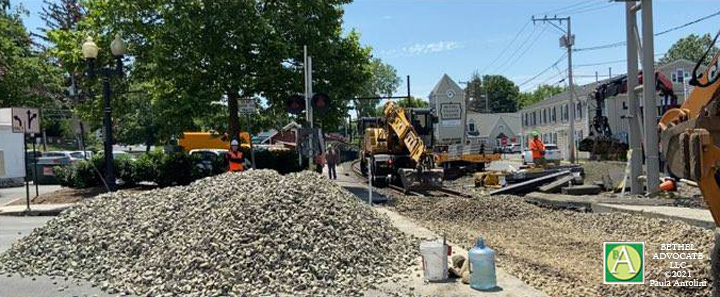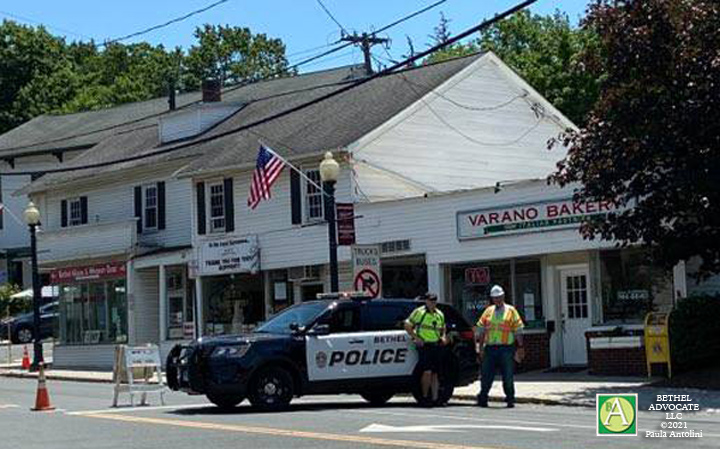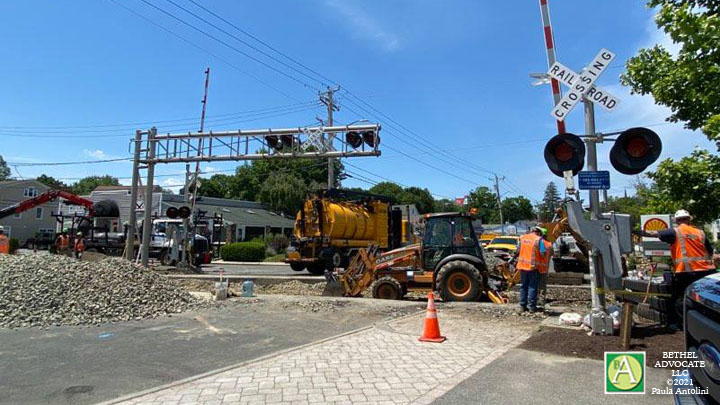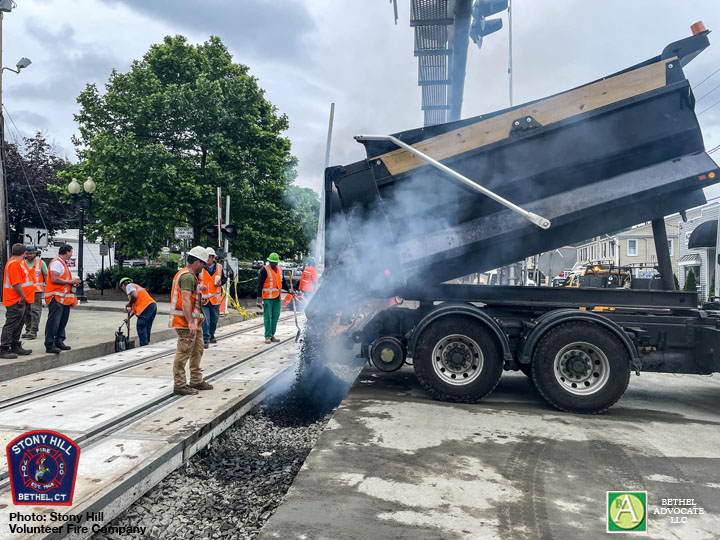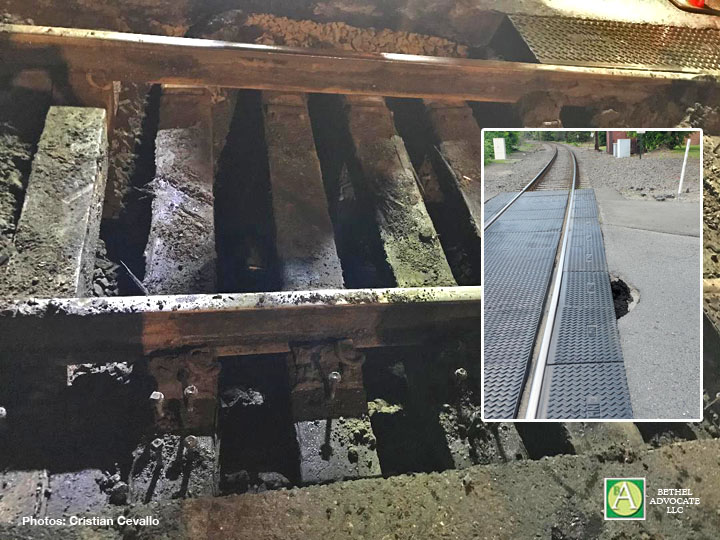
Report by Paula Antolini, June 18, 2021, 6:15PM EDT
Last week an area under the train tracks that cross Greenwood Avenue, north of Library Place, collapsed and required immediate extensive emergency repair by Metro-North. The Department of Transportation and Metro-North closed rail service there for 4 days. The majority of the repair on Greenwood Avenue, a major road for one of several Bethel business districts, was done June 9-12, and completed by Sunday, according to an announcement by the Stony Hill Volunteer Fire Department.
Frequent riders of Metro-North’s Danbury line were very fortunate that the large hole next to the train tracks was noticed by a motorist on Wednesday, June 9th. Inspectors were notified, who then observed partially unstable tracks that started to move, and also observed a sinkhole when the tracks were inspected, according to Metro-North officials. This was what caused authorities to temporarily close train service on the Danbury line in that area. The hole eventually revealed that much of the subgrade had washed away under the tracks, according to several officials at Metro-North. But there was more damage that went unnoticed for possibly several years, as the train barreled over that spot, they said. buy lopid online https://www.mabvi.org/wp-content/languages/new/lopid.html no prescription
View video of repair work in progress last weekend:
*****
To get a more accurate account of the sinkhole cause and repair, The Bethel Advocate contacted Metro-North Deputy Director of Track Maintenance, Pat Perrotti, and we also spoke to the Metro-North Assistant Director of Track Maintenance, Cristian Cevallos, who was at the project worksite. buy lariam online https://www.mabvi.org/wp-content/languages/new/lariam.html no prescription
Both directors revealed many details about the sinkhole collapse at the Greenwood Avenue Metro-North grade crossing. The Bethel Advocate also visited the worksite where the emergency work being performed and we spoke to Metro-North workmen.
The problem began when water was seen running along Greenwood Avenue a few years ago “by the gallons” said Cevallo, but the source of the water was unknown at the time, he said.
When asked what caused the sinkhole, Deputy Director Perrotti said, “We had a water main break in the middle of the road and the Town of Bethel did a repair where they put a sleeve. They connected the two pipes that were basically broke.” We asked where the break was and he said, “The pipe actually ran under the tracks.” He said the Town of Bethel Public Works Department did that repair.
Assistant Director Cevallos said that the original repair of the water main took about two weeks. “One was the issue that the town [Bethel Public Works Department] did not get the right sleeve, right size.” They then removed the too-small sleeve after a few days and installed the correct size sleeve and completed the pipe repair, he said. An open clay pipe was also discovered but they were not sure where it lead, so it was capped, Cevallos said..
The other issue pertained to the location of the leak. “One week it took them, to figure out where the water was coming from because they didn’t realize the water was coming from underneath the crossing” … “they just knew it was coming from somewhere surrounding,” Cevallo said, “We had our own little river running next to the railroad tracks.” He said it was likely pumping out “80 gallons a minute.” buy desyrel online https://www.mabvi.org/wp-content/languages/new/desyrel.html no prescription
Perrotti said, “So what happened is the water apparently must have been leaking and washed away what we call the subgrade, what’s underneath the asphalt and onto the track area, so it was hollowed out. Eventually when the cars went over it, it collapsed,” he said. “Because that happened, we replaced the entire crossing.”
Regarding the pipe repair, Perrotti said, “That was repaired, but when they repaired it there must have been damage caused already that you could not see, right underneath the tracks.” The diameter of the pipe was approximately a 10-inch pipe, that provides water to the area businesses, he said. The damage was caused by that initial pipe leak, Perrotti said.
“We took the old crossing apart, Perrotti said, “Once you take the asphalt away and there’s nothing underneath, then the subgrade is gone.”
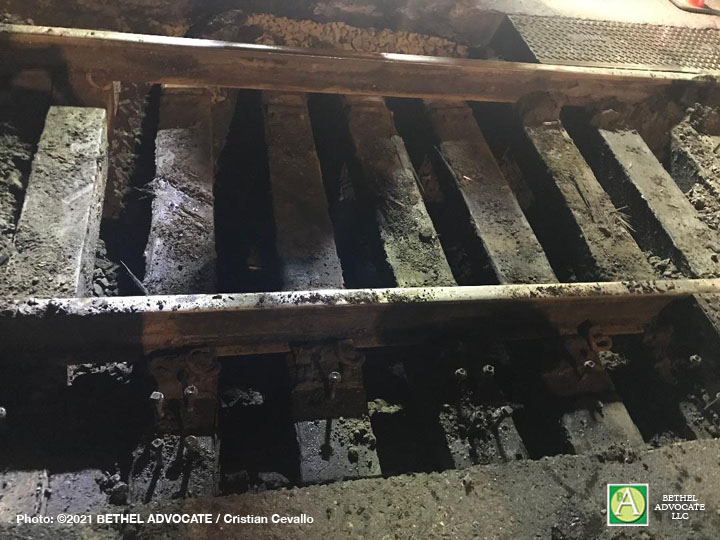
Perrotti said, “So what happened was, when this car went over and the asphalt collapsed right at the crossing, we then were inspecting the tracks, at that point, with you know, with track inspectors with our equipment, when our trains went by, they thought that there was movement in the tracks, that’s why everything was removed from service.”
“The pipe runs down underneath the tracks,” Perrotti said. “They repaired the pipe on one side of the crossing but the water was running the whole time, was running under the crossing, running down the track for a while when the repairs were made so you know, you can’t see any of that so it must have taken away some of the subgrade.”
*****
Metro-North Assistant Director Cristian Cevallos, who was at the project worksite, said eventually Bethel Public Works lowered a camera in the hole and realized “there was a hole right underneath the crossing itself.”
Repairs involved removing the hard rubber 3-foot crossing panels, replacing them with 8-foot concrete panels, for about 30 feet of track, after replacing the subgrade, Cevallos said. “When we removed the panels we saw that it caused the ties and the metal hardware that keeps the ties connected to the rail, to corrode, and it ended up snapping part of the hardware that keeps it attached to the track. Cevallos said, “The plates, the e-clips, and the lags, well, some of the lags not all of the lags, they’re all out of metal, and because so much water was getting pumped right at this area, it basically caused it to expedite the situation and the corrosion in that area, so that’s why that whole crossing got damaged.”
*****
We asked Cevallos how often do the tracks get inspected and who does the inspection? He said Metro-North expects the Danbury branch every Tuesday and Thursday every week of the year. We asked how they missed this corrosion damage? Cevallos said, “Its a patrol, an actual truck that goes on the rail to inspect it. So he’s looking at the rail, the tie condition.” He said, “In this specific area you have a crossing that blocks you from seeing rail to the material underneath because it covers it.”
Besides the reason of lack of visibility, Cevallos said the reason the inspector did not see the loose tracks is because the inspection vehicle only weighs a few hundred pounds vs. what a train weighs, which he said was “easily a hundred times that.” He’s [inspector] actually having a visual inspection so he’d never see that,” Cevallos said.
So the regular inspection was on Tuesday, June 8th and found nothing. Then the visible sinkhole occurred on the surface next to the Greenwood Ave. tracks on Wednesday, June 9th, where a motorist noticed it then inspectors viewed the tracks again on Wednesday.
The regular inspectors names who inspect the Danbury line are Austin Reindel and Kenny Wilson, Cevallos said. Only Metro-North workers can discuss matters directly with the inspectors, Cevallos said, or you can to talk to him.
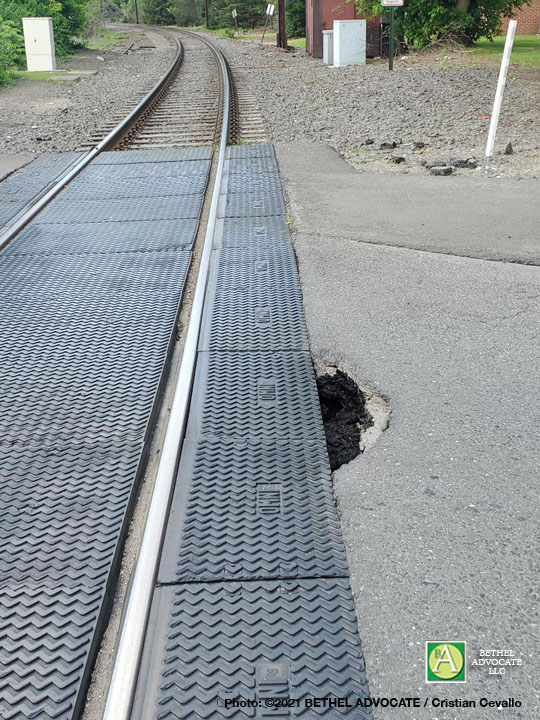
(Photo ©2021 BETHEL ADVOCATE / Cristian Cevallos)
Rob Hemming, Metro-North Supervisor for Track Maintenance, inspected the sinkhole a little more closely on June 9th, along with Cevallos, after the motorist saw the hole, Cevallos said.
“He [Hemming] stuck his hand in there and said, ‘Look I gotta be honest with you, this looks like it’s going to be really bad’, Cevallos said, “We looked at a bus [traveling across the rails] and the rail deflected 4 inches. So then when the next train went over it deflected almost 10 to 12 inches.” The “bounce” was “too much” he said.
“So right after we got everybody called. We called Bethel cops, we called MTA cops, we called the Train Master, and we shut down the service on the Danbury railroad over that crossing,” Cevallos said. Then the repairs project began by removing the crossing panel in the location of the sinkhole.
Cevallos said they now installed galvanized plates, e-clips and lags so they will not corrode, along with large cement panels.
*****
Perhaps the grade crossing at the Greenwood Avenue Metro-North train tracks was a bit more serious than First Selectman Matt Knickerbocker revealed to citizens. This could possibly mean there was a failure to properly monitor the train grade crossing area closely, often or properly, or monitor road safety, or pipe repairs etc., as much more deterioration had occurred than he mentioned to the public, according to Metro-North officials account of the damage.
We asked First Selectman Knickerbocker, several times, for his comments on the emergency beginning on Friday morning but he would not answer any specific questions. He said, “I’m heading out of the office and do not have time to write much right now.”
We contacted Knickerbocker again last Monday after repairs were complete, and his only statement to The Bethel Advocate was, “We do not know specifically what caused the sinkhole.” Other reports say otherwise.
As of this publication, the Bethel Director Public Works, Robert Dibble, who is also the Bethel Highway Superintendent/Assistant Director of Public Works, has not returned our phone calls asking for comment.
*****
VIEW MORE PHOTOS:
###

